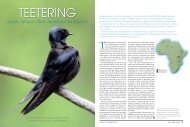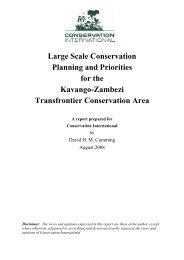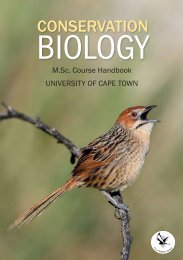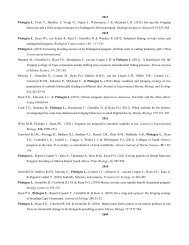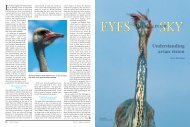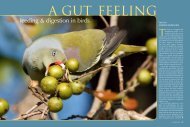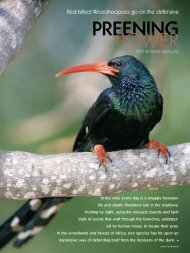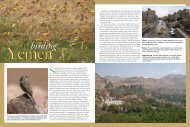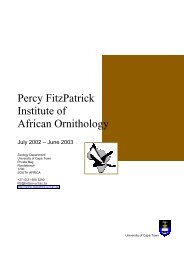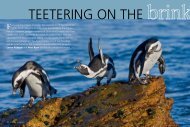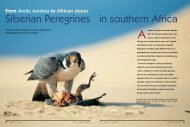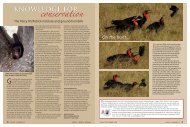The ghost in the Mavunda: birding north-west Zambia
The ghost in the Mavunda: birding north-west Zambia
The ghost in the Mavunda: birding north-west Zambia
- No tags were found...
You also want an ePaper? Increase the reach of your titles
YUMPU automatically turns print PDFs into web optimized ePapers that Google loves.
<strong>The</strong> Ghost <strong>in</strong><strong>the</strong> <strong>Mavunda</strong>PETER RYAN (2)<strong>Zambia</strong> straddles <strong>the</strong> miombo wood land belt that dom<strong>in</strong>ates much of south–central Africa. Inaddition to miombo birds, sou<strong>the</strong>rn African semi-arid species penetrate <strong>the</strong> south-<strong>west</strong> of <strong>the</strong>country, and Congolese forest species straggle <strong>in</strong>to <strong>the</strong> <strong>north</strong>-<strong>west</strong>.This latter group was <strong>the</strong> target of a recent trip to <strong>north</strong>-<strong>west</strong>ern <strong>Zambia</strong> by Peter Ryan andRod Cassidy. Top of <strong>the</strong>ir wishlist was <strong>the</strong> enigmatic White-chested T<strong>in</strong>ker bird, known from onlya s<strong>in</strong>gle specimen collected <strong>in</strong> 1962.When Con Benson’s Birds of<strong>Zambia</strong> was published <strong>in</strong> <strong>the</strong>1970s, it was immediatelyap parent that for South African birders,Mw<strong>in</strong>ilunga was <strong>the</strong> most important placeto visit. Sandwiched between Angola and<strong>the</strong> Democratic Republic of Congo (DRC),<strong>the</strong> Mw<strong>in</strong>ilunga district is home to numerousspecies that are found nowhere else <strong>in</strong><strong>Zambia</strong>. It is only <strong>in</strong> <strong>the</strong> last decade that<strong>Zambia</strong> has become accessible to SouthAfricans, but surpris<strong>in</strong>gly few have availed<strong>the</strong>mselves of <strong>the</strong> chance to visit this greatbird<strong>in</strong>g area, which is readily accessible byroad.Hav<strong>in</strong>g previously birded sou<strong>the</strong>rn andeastern <strong>Zambia</strong>, we rushed <strong>north</strong> throughLusaka and <strong>west</strong> across <strong>the</strong> sprawl<strong>in</strong>gCopperbelt to start bird<strong>in</strong>g at Mutanda, asmall village midway to Mw<strong>in</strong>ilunga. Here,<strong>the</strong> Mutanda River road bridge supports alarge colony of Red-throated Cliff Swallows,which are easily observed as <strong>the</strong>y leave <strong>the</strong>colony at dawn and return at dusk. <strong>The</strong>irpresence is less predictable at o<strong>the</strong>r timesof day, so it’s worth spend<strong>in</strong>g a night at<strong>the</strong> rustic Mutanda Falls Lodge. Whilewait<strong>in</strong>g for <strong>the</strong> swallows to put <strong>in</strong> anappearance, visit <strong>the</strong> adjacent riparian forest– it supports a selection of <strong>in</strong> terest<strong>in</strong>gbirds, <strong>in</strong>clud<strong>in</strong>g <strong>the</strong> gaudy Ross’s Turacosand Black-backed Barbets, ex quisite Whitech<strong>in</strong>nedPr<strong>in</strong>ias, and noisy parties ofYellow-throated Leafloves.Above Dawn break<strong>in</strong>g over MutandaFalls. You have to imag<strong>in</strong>e <strong>the</strong>accompany<strong>in</strong>g chorus of Ross’sTuracos and White-ch<strong>in</strong>ned Pr<strong>in</strong>ias...Opposite <strong>Mavunda</strong> – <strong>the</strong> tall, dryCryptosepalum woodland which is hometo Margaret’s Batis, Perr<strong>in</strong>’s Bush-Shrikeand <strong>the</strong> only known specimen of WhitechestedT<strong>in</strong>kerbird.december 2002/january 2003<strong>north</strong>-<strong>west</strong> zambia37
ANGOLAM<strong>in</strong>yanya Pla<strong>in</strong>LiuwaPla<strong>in</strong>NationalParkChavumaZambeziZambeziSaluj<strong>in</strong>gaSiomaNgweziNationalParkHillwood FarmZambezi sourceChitunta Pla<strong>in</strong>Mw<strong>in</strong>ilungaW. LungaNationalMayau ParkKabompoZAMBIAMutandaKafueNationalParkLiv<strong>in</strong>gstoneHead<strong>in</strong>g fur<strong>the</strong>r <strong>west</strong>, <strong>the</strong>re are stillsome patches of tall miombowoodland along <strong>the</strong> ma<strong>in</strong> road,seven kilometres beyond <strong>the</strong> MwombezhiRiver. A stop here produced <strong>the</strong> patchilydistributedand ra<strong>the</strong>r elusive Bar-w<strong>in</strong>gedWeaver. This oddly-plumaged weaver is<strong>the</strong> <strong>west</strong>ern counterpart of Olive-headedWeaver, occurr<strong>in</strong>g <strong>in</strong> pairs,DEMOCRATICREPUBLIC OFCONGOCh<strong>in</strong>golaLusakaLake Karibaglean<strong>in</strong>g <strong>in</strong>sects from epiphyticlichens on treebranches, and build<strong>in</strong>gnests made of old man’sbeard lichen (Usnea). <strong>The</strong>miombo bird parties arelikely to conta<strong>in</strong> severalo<strong>the</strong>r species not found <strong>in</strong>sou<strong>the</strong>rn Africa, such asBöhm’s and White-tailedBlue fly catchers, Red-cappedCrom bec, ChestnutmantledSparrow-WeaverandBlackcollaredEremo mela, aswell as Stripe-breastedSeed eater. Tabora Cisticolasare commonly seen <strong>in</strong> <strong>the</strong>grassy understorey.Ano<strong>the</strong>r few hours’drive br<strong>in</strong>gs you to <strong>the</strong>town of Mw<strong>in</strong>ilunga. Here<strong>the</strong> road bends <strong>north</strong>, and<strong>the</strong> tar peters out. You<strong>the</strong>n pass through ano<strong>the</strong>rgood patch of miombo<strong>The</strong> Chitunta Pla<strong>in</strong>, between Mw<strong>in</strong>ilunga and Hillwood Farm, is <strong>the</strong> easiest place to seeGrimwood’s Longclaw. It’s also good for Black-and-rufous Swallow, Bocage’s Weaverand a host of grassland species.PETER RYANwoodland which also supports Bar-w<strong>in</strong>gedWeavers. After a fur<strong>the</strong>r 30 kilometres <strong>the</strong>road crosses <strong>the</strong> Chitunta Pla<strong>in</strong>, a largegrassy dambo with a perennial streamrunn<strong>in</strong>g through it. This is <strong>the</strong> best knownsite for Grim wood’s Long claw, a localisedspecies found <strong>in</strong> Angola and adjacentareas of <strong>the</strong> DRC and <strong>Zambia</strong>. We weren’texpect<strong>in</strong>g too much from this species butit proved to be a pleasant surprise, andmuch more attractive than <strong>the</strong> field guidessuggest. It is very large for a longclaw,with a long, deep bill, and rich buff plumageheavily streaked with dark brown. Itlacks a neat black gorget, but this doesn’tdetract from its looks. Several <strong>in</strong>dividualswere quite approachable <strong>in</strong> <strong>the</strong> wettergrassland close to <strong>the</strong> river, where <strong>the</strong>yoccur alongside <strong>the</strong> more widespreadFülleborn’s and P<strong>in</strong>k-throated longclaws.Chitunta also has o<strong>the</strong>r jewels to offer.Probably <strong>the</strong> best is <strong>the</strong> <strong>in</strong>comparableBlack-and-rufous Swallow. This small,short-tailed swallow is dark <strong>in</strong>digo aboveand rich chestnut-red below. Pairs flit lowover <strong>the</strong> pla<strong>in</strong> toge<strong>the</strong>r with <strong>the</strong> moreabundant Grey-rumped Swallows. <strong>The</strong>ybreed dur<strong>in</strong>g <strong>the</strong> dry season and leaveMw<strong>in</strong>ilunga dur<strong>in</strong>g <strong>the</strong> summer ra<strong>in</strong>yseason. <strong>The</strong> pla<strong>in</strong>’s grassland is also hometo Black-ch<strong>in</strong>ned Quailf<strong>in</strong>ches, LocustF<strong>in</strong>ches, Marsh Widows, White-cheekedBee-eaters, Swamp (or Natal) Nightjarsand numerous cisticolas, <strong>in</strong>clud<strong>in</strong>g <strong>the</strong>handsome Dambo (or Black-tailed)Cisticola. Some two kilometres downstream,above <strong>the</strong> confluence with <strong>the</strong>Luakera River, trees overhang<strong>in</strong>g <strong>the</strong> riversupport a colony of <strong>the</strong> highly localisedBocage’s Weaver (formerly considered asubspecies of Cape Weaver) from <strong>the</strong> endof July onwards.North of Chitunta lies <strong>the</strong> source of<strong>the</strong> Zambezi River – a small spr<strong>in</strong>g aris<strong>in</strong>gfrom with<strong>in</strong> a patch of dense gallery forestor mushitu. This forest is home tomany of <strong>the</strong> Congolese birds that reach<strong>the</strong>ir sou<strong>the</strong>rn limit <strong>in</strong> Mw<strong>in</strong>ilunga. Greyw<strong>in</strong>gedRob<strong>in</strong>-Chats skulk close to <strong>the</strong>forest floor and are best located by <strong>the</strong>irslightly mournful, whistled song. CommonBristlebills and Rufous-belliedParadise-Flycatchers also occur <strong>in</strong> <strong>the</strong>understorey or mid-canopy, but by far<strong>the</strong> hardest bird to see <strong>in</strong> this habitat is<strong>the</strong> reclusive Bamboo Warbler, which isalmost impossible to locate if it’s notcall<strong>in</strong>g. Olive Long-tailed Cuckoos andBlue-breasted K<strong>in</strong>gfishers are also moreeasily heard than seen as <strong>the</strong>y call from<strong>the</strong> forest canopy. O<strong>the</strong>r canopy species<strong>in</strong>clude Afep and Western Bronze-napedpigeons and Honeyguide Greenbul, whileRufous Ant-Thrush, Laura’s WoodlandWarbler, Buff-throated Apalis and Bates’Sunbird are more conspicuous around<strong>the</strong> forest edge. In <strong>the</strong> mushitu and adjacentdense miombo may be found <strong>the</strong>local ised Bannerman’s Sunbird, a smallbilledversion of Green-headed Sunbirdwith bluer iridescence on its head.From its source, <strong>the</strong> Zambezi flows eastand <strong>north</strong>, before bend<strong>in</strong>g <strong>west</strong> andhead<strong>in</strong>g off <strong>in</strong>to Angola. Near its nor<strong>the</strong>rnmostpo<strong>in</strong>t, <strong>the</strong> river flows over alarge granite outcrop, form<strong>in</strong>g a series ofshallow rapids. This is <strong>the</strong> most reliablesite <strong>in</strong> <strong>Zambia</strong> for Forbes’s Plover, <strong>the</strong>West African version of Three-bandedPlover. Dead snags overhang<strong>in</strong>g <strong>the</strong> riverare <strong>the</strong> haunt of Cass<strong>in</strong>’s Grey Flycatcher,and <strong>the</strong> remnants of riparian woodlandsupport many of <strong>the</strong> region’s sought-afterforest species.But for <strong>the</strong> biggest hit of Congolesespecies, you have to go even fur<strong>the</strong>r<strong>north</strong>, past Saluj<strong>in</strong>ga, where <strong>the</strong> luckybirder may f<strong>in</strong>d White-spotted Flufftail,Brown-eared Woodpecker, White-belliedK<strong>in</strong>gfisher, Spotted Thrush-Babbler, ChestnutWattle-eye, Sooty Flycatcher, PETE LEONARD (2)PETER RYANBird<strong>in</strong>g outside<strong>the</strong> box…<strong>The</strong> burgeon<strong>in</strong>g <strong>in</strong>terest <strong>in</strong> bird<strong>in</strong>g <strong>in</strong>sou<strong>the</strong>rn Africa has seen a great<strong>in</strong>crease <strong>in</strong> bird<strong>in</strong>g throughout <strong>the</strong>region, with impressive sp<strong>in</strong>-offs <strong>in</strong>terms of our knowledge of <strong>the</strong> region’sbirds and <strong>the</strong> conservation of <strong>the</strong>irhabitats. However, relatively few sou<strong>the</strong>rnAfrican birders venture <strong>north</strong> of<strong>the</strong> subregion’s boundaries. This ispartly due to <strong>the</strong> geographical limits of<strong>the</strong> region’s field guides, but it is exacerbatedby <strong>the</strong> competitive list<strong>in</strong>g fraternity,which equates one’s ability as abirder to <strong>the</strong> size of one’s regional birdlist. It seems somewhat trivial to birdfrantically along <strong>the</strong> Zambezi orKunene rivers <strong>in</strong> <strong>the</strong> hope of see<strong>in</strong>g avagrant Angola Swallow or Shelley’sSunbird, when <strong>the</strong>se and many moreexcit<strong>in</strong>g species can be seen by simplycross<strong>in</strong>g <strong>the</strong> river and ventur<strong>in</strong>g a littlefur<strong>the</strong>r <strong>north</strong>.We challenge sou<strong>the</strong>rn Africa birdersto broaden <strong>the</strong>ir horizons. Startth<strong>in</strong>k<strong>in</strong>g global or Africa-wide. If that’stoo much, how about expand<strong>in</strong>gsou<strong>the</strong>rn Africa’s boundaries to <strong>in</strong>cludeAngola, <strong>Zambia</strong>, Malawi and nor<strong>the</strong>rnMozambique? This would close <strong>the</strong>gap between our region and East andWest Africa, and boost <strong>the</strong> region’s listto more than 1 250 species. Forget <strong>the</strong>800 club – what about <strong>the</strong> 1 000club?Above left Grey-w<strong>in</strong>ged Rob<strong>in</strong>-Chat is aretir<strong>in</strong>g species of <strong>the</strong> mushitu understorey,best located by its quaver<strong>in</strong>g song at dawnand dusk.Above right Bannerman’s Sunbird closelyresembles a Green-headed Sunbird, but isslightly smaller with a shorter bill and bluerhead. It is restricted to <strong>north</strong>-<strong>west</strong> <strong>Zambia</strong>and adjacent Angola and <strong>the</strong> DRC.Left A pair of elusive White-throatedFrancol<strong>in</strong>s on <strong>the</strong> M<strong>in</strong>yanya Pla<strong>in</strong>s.38 <strong>north</strong>-<strong>west</strong> zambiaafrica – birds & bird<strong>in</strong>gdecember 2002/january 2003<strong>north</strong>-<strong>west</strong> zambia39
PETE LEONARD (2)<strong>The</strong> Black-collared Bulbul looks more like abush-shrike than a bulbul, but recent evidenceconfirms its placement with <strong>the</strong> bulbuls.It is quite widespread <strong>in</strong> Central Africa,but can be elusive and is one of <strong>the</strong> soughtafterspecials <strong>in</strong> <strong>north</strong>-<strong>west</strong> <strong>Zambia</strong>.Laura’s Woodland Warbler is a localisedendemic, mostly restricted to mushitu forestpatches and adjacent woodland <strong>in</strong> nor<strong>the</strong>rn<strong>Zambia</strong> and <strong>the</strong> sou<strong>the</strong>rn DRC.Orange-tufted Sunbird or Compact Weaver<strong>in</strong> <strong>the</strong> rema<strong>in</strong><strong>in</strong>g mushitu patches. This is<strong>the</strong> best area <strong>in</strong> <strong>Zambia</strong> to see <strong>the</strong> stun n<strong>in</strong>gBlack-bellied Seed cracker, and <strong>the</strong>re is al ways<strong>the</strong> chance of turn<strong>in</strong>g up a new spe ciesfor <strong>the</strong> country; Pete Leonard recentlyfound a female Shrike Flycatcher here.<strong>The</strong> most famous bird<strong>in</strong>g site <strong>in</strong> Mw<strong>in</strong>ilungais Hillwood Farm, a large commercialfarm and game reserve east of Ikelenge.It offers a mix of open grassy pla<strong>in</strong>s,mushitu forest and well-conservedmiombo woodland, and is an excellentbase for explor<strong>in</strong>g <strong>the</strong> region. It is a goodplace to f<strong>in</strong>d <strong>the</strong> strik<strong>in</strong>g, ra<strong>the</strong>r shrikelikeBlack-collared Bulbul, which prefersscrubby thicket vegetation, and is bestlocated adjacent to <strong>the</strong> airstrip <strong>north</strong> ofSakeji mission. Ano<strong>the</strong>r forest-edge speciesthat reaches its sou<strong>the</strong>rn limit here is<strong>the</strong> Whistl<strong>in</strong>g Cisticola, which skulks <strong>in</strong>bracken along <strong>the</strong> edges of mushitu.<strong>The</strong> open pla<strong>in</strong>s <strong>in</strong> <strong>the</strong> reserve are wellstocked with a variety of game, <strong>in</strong>clud<strong>in</strong>g<strong>The</strong> source of <strong>the</strong> Zambezi – a small, dark spr<strong>in</strong>g, deep <strong>in</strong> mushitu forest.PETER RYANsable (which shows aff<strong>in</strong>ities to <strong>the</strong> giantAngolan form), Lichtenste<strong>in</strong>’s hartebeest,Defassa waterbuck, nor<strong>the</strong>rn pla<strong>in</strong>s zebra,puku and oribi. <strong>The</strong> pla<strong>in</strong>s are also hometo an array of larks, pipits, longclaws andcisticolas, prime among which is <strong>the</strong>Angola Lark. Intermediate <strong>in</strong> size betweenRufous-naped and Flappet larks, it has abeautiful trill<strong>in</strong>g call, with no clear aff<strong>in</strong>ityto o<strong>the</strong>r Mirafra larks. In <strong>the</strong> earlymorn<strong>in</strong>g, when <strong>the</strong> grass is wet, manybirds come out on to <strong>the</strong> roads, allow<strong>in</strong>ggreat views of o<strong>the</strong>rwise reclusive specieslike Locust F<strong>in</strong>ch and Black-rumpedButtonquail.<strong>Zambia</strong>’s North-<strong>west</strong>ern Prov<strong>in</strong>ce hasmore to offer than just <strong>the</strong> Mw<strong>in</strong>ilungaarea. In <strong>the</strong> far <strong>west</strong>, <strong>the</strong> Zambezi Riverre-enters <strong>Zambia</strong> from Angola at Chavuma.Here we crossed <strong>the</strong> already sizable riverby ferry and drove ano<strong>the</strong>r 35 kilometresalong a sandy track to reach <strong>the</strong> vastexpanse of <strong>the</strong> M<strong>in</strong>yanya Pla<strong>in</strong>. This ishome to an isolated population of WhitethroatedFrancol<strong>in</strong>, a species o<strong>the</strong>rwiseconf<strong>in</strong>ed to <strong>the</strong> arid savannas of WestAfrica. Related to Coqui Francol<strong>in</strong>, it hassimilar calls and prefers to freeze ra<strong>the</strong>rthan flush. It lives <strong>in</strong> much more openterra<strong>in</strong>, but is remarkably easy to overlookif it’s not call<strong>in</strong>g. We spent a frustrat<strong>in</strong>gday chas<strong>in</strong>g this species before we f<strong>in</strong>allybumped <strong>in</strong>to a small covey. O<strong>the</strong>r <strong>in</strong>terest<strong>in</strong>gbirds <strong>in</strong>clude White-bellied Bustard,Sooty Chat, a very different race of RufousnapedLark and some very odd pipits. Atnight <strong>the</strong> pla<strong>in</strong>s r<strong>in</strong>g with <strong>the</strong> calls ofSwamp Nightjars.Fur<strong>the</strong>r east <strong>the</strong>re are patches of Cryptosepalumforest, known locally as mavunda.This dry forest is dist<strong>in</strong>guished from <strong>the</strong>surround<strong>in</strong>g miombo woodland by itsvery tall canopy and dense, almost impenetrableunderstorey which holds <strong>the</strong> stunn<strong>in</strong>gPerr<strong>in</strong>’s Bush-Shrike. A close relativeof Gorgeous Bush-Shrike, it makes a similar‘kong-kong-koit’ call and even respondsto playback of Gorgeous Bush-Shrike song.<strong>The</strong> mavunda is one of <strong>the</strong> easiest places tosee <strong>the</strong> local ised Mar g aret’s Batis, whichco-occurs with Ch<strong>in</strong> spot Batis, but typicallyis found at lower levels <strong>in</strong> <strong>the</strong> forest.<strong>The</strong> males of <strong>the</strong> two species are quitesimilar, but female Marg aret’s Batises havebuffy w<strong>in</strong>g bars, a diffuse buffy breastband and no throat spot.But <strong>the</strong> real attraction of bird<strong>in</strong>g <strong>the</strong>mavunda is <strong>the</strong> chance, however slim, ofrelocat<strong>in</strong>g <strong>the</strong> enigmatic White-chestedOFF YOU GO!In general, <strong>north</strong>-<strong>west</strong> <strong>Zambia</strong> isnot geared for tourism, and visitorsshould plan to be largely self-sufficient.<strong>The</strong> best time to visit is fromAugust to October, before <strong>the</strong> summerra<strong>in</strong>s beg<strong>in</strong> <strong>in</strong> earnest. <strong>The</strong> ra<strong>in</strong>sgenerally start earlier <strong>in</strong> Mw<strong>in</strong>ilungathan elsewhere <strong>in</strong> <strong>Zambia</strong>, and <strong>the</strong>birds are most vocal just before <strong>the</strong>onset of <strong>the</strong> ra<strong>in</strong>s. Visit<strong>in</strong>g before<strong>the</strong> ra<strong>in</strong>s also means that <strong>the</strong> roadsare still <strong>in</strong> reasonable condition.Birders plann<strong>in</strong>g to stay at HillwoodFarm should book via <strong>the</strong> websitewww.nchila-wildlife-reserve.com ore-mail nchila@compuserve.com. Youcan fly <strong>in</strong>to Hillwood direct fromLusaka, but most people drive <strong>the</strong>re.<strong>The</strong> tar road to Mw<strong>in</strong>ilunga from <strong>the</strong>Copper belt is potholed <strong>in</strong> places, butis o<strong>the</strong>rwise f<strong>in</strong>e. <strong>The</strong> dirt roads <strong>north</strong>of Mw<strong>in</strong>ilunga and south to <strong>the</strong>mavunda are f<strong>in</strong>e for two-wheel-drivevehicles, at least dur<strong>in</strong>g <strong>the</strong> dry season.<strong>The</strong> ma<strong>in</strong> road to Chavumathrough Zambezi is heavily-ruttedgravel, and needs to be travelledquite slowly. Beyond Chavuma, <strong>the</strong>track to M<strong>in</strong>yanya requires a fourwheel-drivevehicle.Fuel availability can be an issue,es pe cially if you want to visitM<strong>in</strong>yanya. <strong>The</strong>re is usually fuel <strong>in</strong>Mw<strong>in</strong>ilunga town and Kabompo,and occasionally <strong>in</strong> Zam bezi, butT<strong>in</strong>kerbird. Jali Makawa, Con Benson’sfamous collector, shot <strong>the</strong> sole specimennear Mayau <strong>in</strong> 1962. Reports tell that hewas attracted by its slightly different call.We birded several patches of mavunda,<strong>in</strong> clud<strong>in</strong>g <strong>the</strong> largest easily accessiblepatch, five kilometres <strong>north</strong> of Mayau.Although <strong>the</strong>re were lots of Goldenrumpedand Yellow-fronted t<strong>in</strong>kerbirds,none sounded odd, or showed a blackbelly patch and pla<strong>in</strong> black face. Discouragedby <strong>the</strong> omni present sweat-bees,we left <strong>the</strong> mavunda and headed for home.But we couldn’t help wonder<strong>in</strong>g if somewhere<strong>the</strong>re isn’t a thriv<strong>in</strong>g population ofWhite-chested T<strong>in</strong>ker birds just wait<strong>in</strong>g tobe discovered. <strong>The</strong>re’s certa<strong>in</strong>ly still plentyof habitat where <strong>the</strong> <strong>ghost</strong> of <strong>the</strong> mavundacould be hid<strong>in</strong>g…PETER RYAN<strong>The</strong> name says it all – travell<strong>in</strong>g <strong>in</strong> <strong>the</strong>area can be somewhat challeng<strong>in</strong>g for<strong>the</strong> ill-prepared visitor.take every opportunity to fill up <strong>in</strong>case <strong>the</strong> next town is out of supplies.Bird guides to use <strong>in</strong>clude <strong>the</strong> FieldGuide to <strong>Zambia</strong>n Birds (Asp<strong>in</strong>wall &Beel), which illustrates all <strong>the</strong> speciesnot covered by <strong>the</strong> sou<strong>the</strong>rn Africanfield guides, and has distributionmaps for <strong>the</strong>se species. It should beused <strong>in</strong> conjunction with good sou<strong>the</strong>rnand East African field guides. VanPerlo’s Illustrated Checklist to <strong>the</strong> Birdsof Sou<strong>the</strong>rn Africa also covers <strong>Zambia</strong>.<strong>The</strong> classic Birds of <strong>Zambia</strong> (Benson etal.) is useful, giv<strong>in</strong>g <strong>in</strong>forma tion ongeographic variation with<strong>in</strong> <strong>Zambia</strong>.Anyone want<strong>in</strong>g <strong>in</strong>formation orguidance can contact <strong>the</strong> <strong>Zambia</strong>nOrnitho logical Society(www.fisheagle.org, zos@zamnet.zm)or Cassidy Bird Tours (Cassbirds@yahoo.com).40 <strong>north</strong>-<strong>west</strong> zambiaafrica – birds & bird<strong>in</strong>gdecember 2002/january 2003<strong>north</strong>-<strong>west</strong> zambia41



